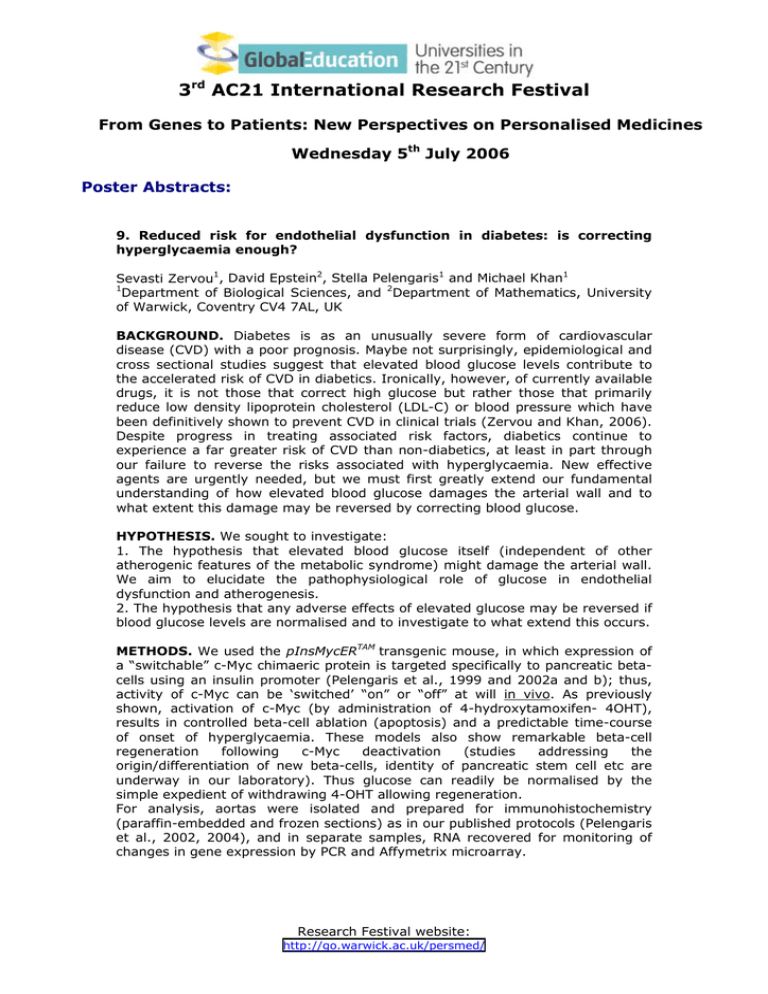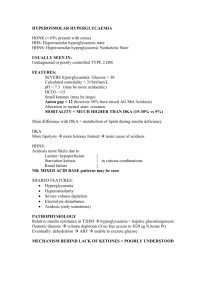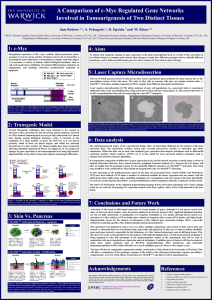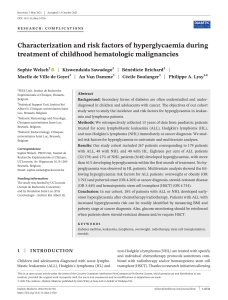3 AC21 International Research Festival
advertisement

3rd AC21 International Research Festival From Genes to Patients: New Perspectives on Personalised Medicines Wednesday 5th July 2006 Poster Abstracts: 9. Reduced risk for endothelial dysfunction in diabetes: is correcting hyperglycaemia enough? Sevasti Zervou1, David Epstein2, Stella Pelengaris1 and Michael Khan1 1 Department of Biological Sciences, and 2Department of Mathematics, University of Warwick, Coventry CV4 7AL, UK BACKGROUND. Diabetes is as an unusually severe form of cardiovascular disease (CVD) with a poor prognosis. Maybe not surprisingly, epidemiological and cross sectional studies suggest that elevated blood glucose levels contribute to the accelerated risk of CVD in diabetics. Ironically, however, of currently available drugs, it is not those that correct high glucose but rather those that primarily reduce low density lipoprotein cholesterol (LDL-C) or blood pressure which have been definitively shown to prevent CVD in clinical trials (Zervou and Khan, 2006). Despite progress in treating associated risk factors, diabetics continue to experience a far greater risk of CVD than non-diabetics, at least in part through our failure to reverse the risks associated with hyperglycaemia. New effective agents are urgently needed, but we must first greatly extend our fundamental understanding of how elevated blood glucose damages the arterial wall and to what extent this damage may be reversed by correcting blood glucose. HYPOTHESIS. We sought to investigate: 1. The hypothesis that elevated blood glucose itself (independent of other atherogenic features of the metabolic syndrome) might damage the arterial wall. We aim to elucidate the pathophysiological role of glucose in endothelial dysfunction and atherogenesis. 2. The hypothesis that any adverse effects of elevated glucose may be reversed if blood glucose levels are normalised and to investigate to what extend this occurs. METHODS. We used the pInsMycERTAM transgenic mouse, in which expression of a “switchable” c-Myc chimaeric protein is targeted specifically to pancreatic betacells using an insulin promoter (Pelengaris et al., 1999 and 2002a and b); thus, activity of c-Myc can be ‘switched’ “on” or “off” at will in vivo. As previously shown, activation of c-Myc (by administration of 4-hydroxytamoxifen- 4OHT), results in controlled beta-cell ablation (apoptosis) and a predictable time-course of onset of hyperglycaemia. These models also show remarkable beta-cell regeneration following c-Myc deactivation (studies addressing the origin/differentiation of new beta-cells, identity of pancreatic stem cell etc are underway in our laboratory). Thus glucose can readily be normalised by the simple expedient of withdrawing 4-OHT allowing regeneration. For analysis, aortas were isolated and prepared for immunohistochemistry (paraffin-embedded and frozen sections) as in our published protocols (Pelengaris et al., 2002, 2004), and in separate samples, RNA recovered for monitoring of changes in gene expression by PCR and Affymetrix microarray. Research Festival website: http://go.warwick.ac.uk/persmed/ 3rd AC21 International Research Festival RESULTS. The induction of hyperglycaemia in the pInsMycERTAM transgenic mice (4 days of increased blood glucose) was shown to decrease the expression of Angiotensin 1 receptor in the arterial wall (n=3). Furthermore, the localisation of VCAM-1 was altered in pInsMycERTAM mice compared to controls; hyperglycaemia shifted the localisation of the molecule from the tunica intima and tunica media (inner layer of endothelium and centre), towards the tunica adventia (outer of the aorta). CONCLUSIONS. We are currently only a few months into this project, but preliminary results as shown are very encouraging, supporting the power of the study model for this purpose. Thus, it appears that hyperglycaemia can alter the expression of a G-protein coupled receptor and of a cell adhesion molecule in the arterial wall. More detailed analyses and time-courses have already been completed and will be analysed by Affymetrix arrays and by qrt-PCR. It is hoped that such new knowledge will reveal new druggable targets for preventing hyperglycaemia-induced damage in the arterial wall and thereby help correct the anomalous situation whereby glucose-lowering drugs fail to demonstrate significant benefits in prevention of CVD. References: Pelengaris SA, Littlewood T, Khan M, Elia G and Evan G. Reversible activation of c-Myc in skin- induction of a complex neoplastic phenotype by a single oncogenic lesion. Molecular Cell 1999;6: 565-577. Pelengaris, S., Khan, M., and Evan, G. Suppression of Myc-induced apoptosis in beta cells exposes multiple innate oncogenic properties of Myc sufficient to trigger immediate carcinogenic progression. Cell, 2002a;109: 321-334. Pelengaris, S., Khan, M., and Evan, G. c-Myc: more than just a matter of life and death. Nature- Reviews Cancer. 2002b;2: 764-776. Pelengaris S, Abouna S, Cheung L, Ifandi V, Zervou S, Khan M. Brief inactivation of c-Myc is not sufficient for sustained regression of c-Myc-induced tumours of pancreatic islets and skin epidermis. BMC Biology. 2004; 21;2:26. Zervou S, Khan M. Role of hyperglycaemia in pathogenesis of diabetic cardiovascular disease. Vascular Disease Prevention 2006; In Press. Funded by the Wellcome Trust and the Leverhulme Trust. Research Festival website: http://go.warwick.ac.uk/persmed/





